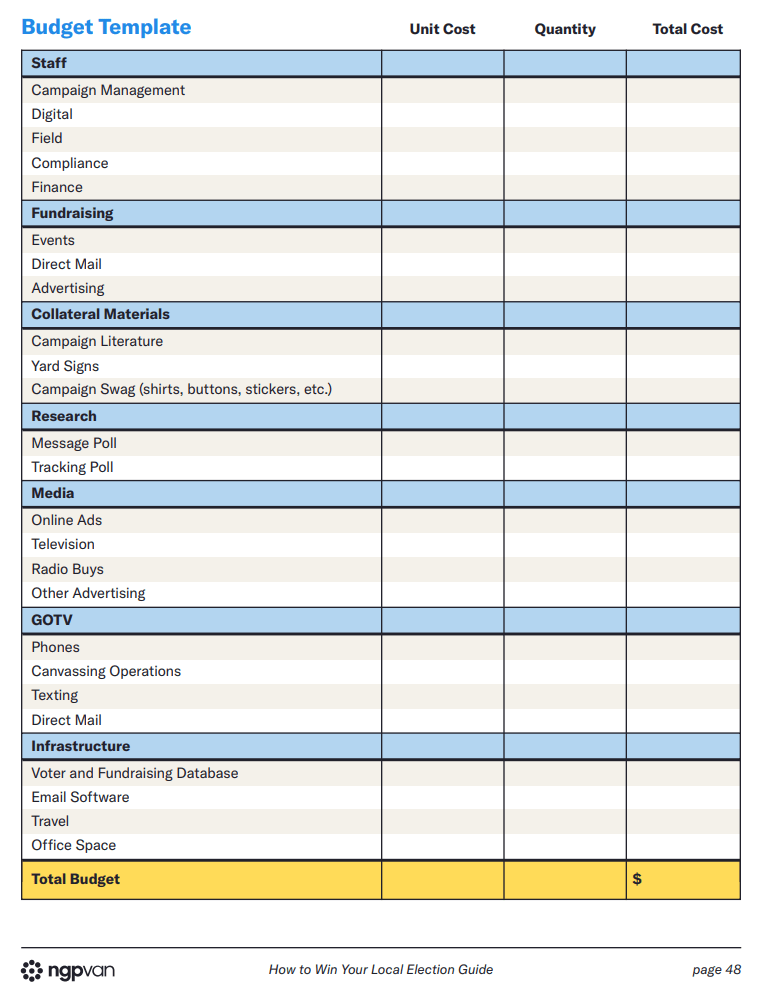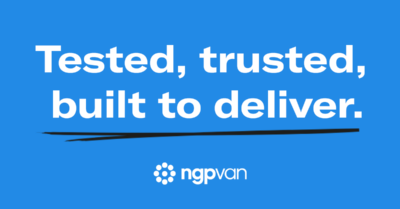Political campaign budget template: How to create a budget

Budgeting is vital for political campaigns. With expenses for everything from campaign advertising to staff pay to fundraising events, campaigns must use their money wisely and efficiently to secure victory on Election Day.
Additionally, financial compliance and transparency are required for campaigns at every election level. The law requires you to have file financial reports, and having a secure means of tracking that budget (like fundraising compliance software) makes reporting easier.
Download our free political campaign budget template created by NGP VAN’s campaign finance experts, and follow along with the steps in this article to create your own budget right away!
How do you create a political campaign budget?
Creating your political campaign budget should be one of the first items on your campaign planning checklist. After researching your district, determining your vote goals, and forming your campaign team, follow these three steps to create a budget.
1. Choose the direction you want to take.
First, determine how you’d like to create your campaign budget based on your finances and resources. There are two main schools of thought for creating a political campaign budget. You can either:
Plan around your fundraising goal.
The first approach is to set a realistic, achievable fundraising goal first. In this scenario, you would research the financial reports of previous campaigns in your area to determine how much winning campaigns have raised and set a similar fundraising goal for your own campaign. Then, build your spending budget around how much money you’ll have available if you reach that fundraising goal.
When researching campaign fundraising and spending totals, focus on the financial data of candidates who won their races. The winning candidate is usually the person with the most resources. OpenSecrets reported that 96% of 2022’s House races were won by the candidate who spent the most money. But the amount that campaigns raise and spend can vary greatly by election level and jurisdiction, so be careful not to base your fundraising goal on the budgets of races that are not similar to yours. The budget of a gubernatorial race will generally not be comparable to the budget of a school board race.
Plan around your expenses.
Alternatively, you can craft your budget with your planned expenses in mind and then set a fundraising goal afterward. If you choose this option, you would map out all of your projected campaign expenses first, then set a fundraising goal to raise enough to cover all of those costs.
This option leads to a more clear-cut budget, but it may cause you to set a fundraising goal that’s less realistic since it doesn’t account for the historical performance of similar campaigns. Choosing the first option will ensure you have a realistic, achievable fundraising goal but might require you to cut the costs of certain expenses if you don’t raise enough to cover them.
How do you determine campaign costs and create a winning budget? Learn more in our free How to Win Your Local Election Guide, which goes through an entire campaign plan.
2. Use our template to track projected and actual costs.
Next, use a resource like our political campaign budget template to break down all of your estimated costs. As you project the cost of things like campaign materials and voter outreach, consider the factors that will impact how much you spend. These include:
- The size of your jurisdiction’s voter pool (The number of voters you need to contact.
- Name recognition – whether your candidate is an incumbent, a well-known figure, or a newcomer.
- How many campaign staff and volunteers you have to help get the word out.
- The types of voter outreach and media you’d like to use.
Our template helps you divide your expenses by category and track spending before, during, and after your campaign. Start by filling in each section of the template with your projected expenses, adjust based on your goal, and then update the budget once you know the actual amounts your campaign spends.
3. Adjust your budget as needed throughout the campaign.
Filling in your budget with the actual cost of each item as you go is not only crucial for compliance, but it also helps you quickly see if you need to reallocate funds. For instance, you might realize in June that you’ve spent more than you expected on email outreach and need to lower your budget for TV ads.
Regularly review your spending as the campaign progresses to ensure you stay on track, and edit your campaign budget when needed based on new expenses or changes to fundraising revenue. A great way to do this is with NGP VAN’s compliance reporting features.
Sample political campaign budget template
The finance experts at NGP VAN have worked on campaigns that have raised billions of dollars, so they know how to create a political campaign budget that works. Our staff have developed two different budget templates using their extensive campaign experience, and we’re sharing both of those with you today.
The first is a simplified version of our full political campaign budget template that you can start using right away:

Use this template as a starting point for building out your campaign budget. It’s a great place to start for smaller campaigns. Or get in the weeds with an interactive, more detailed version that’s similar to what our experts have used in real campaigns.
For the detailed version, download our complete Excel political campaign budget template here.
Costs to include in your campaign budget
Each section of our political campaign budget template covers a different group of common campaign expenses. You may not need to account for every single one of them (and you may have additional expenses), but consider these common costs as you create your budget.
Staff
Depending on how many staff members you have on your campaign team, you may need to supply pay for a:
- Campaign manager
- Communications director
- Field team
- Compliance officer
- Finance director
- Volunteer coordinator
The amount you pay each staff member will vary based on their experience level, but you can explore averages for specific positions online. Don’t forget to factor in the cost of payroll services and any hiring expenses here, too.
Fundraising
The fundraising aspect of your campaign can include several types of costs, including:
- Fundraising event costs such as venue rentals, catering, flyers, technology, and transportation.
- Direct mail appeals, which involve paying for printing, design services, and distribution.
- Advertising via television spots, social media, radio, direct mail, etc.
Some campaigns may also decide to hire a fundraising consultant or a professional designer, which come with their own costs to consider.
Collateral materials
Collateral includes all of the campaign literature that you distribute when canvassing or share with voters online. Project the costs of your campaign’s:
- Pamphlets
- Door hangers
- Posters
- Yard signs
- Website
- Branded t-shirts
- Branded buttons and stickers
Each of these materials will involve design and printing costs. You’ll also need to pay for your website’s domain name and hosting, along with the content management system (CMS) you use and any maintenance costs.
Research
Political campaigns involve a lot of research, both at the beginning and throughout the entire campaign. Plan to pay for:
- Opposition research
- Research on your own candidate
- Opposition tracking
- Media monitoring
- Message polling
- Focus groups
- Ad testing
Media
A significant portion of your political campaign budget should be dedicated to voter outreach. This includes all of the media you’ll use to get your candidate in front of voters, such as:
- Online advertisements
- Television and cable ads
- Radio spots
- Print advertising
- Digital persuasion
- Ad design and development
Advertising can get expensive, so check out our webinar on advertising budgets to learn how smaller campaigns can approach them.
GOTV
Get Out The Vote (GOTV) is an important aspect of any campaign plan, so we’ve created a separate category for this type of outreach. In this section, track the cost of:
- Phone banking
- Canvassing operations
- Texting
- Direct mail
- Digital GOTV outreach
Even though many campaigns rely on volunteers for GOTV, you still need to consider the costs of things like canvassing tools, volunteer recruitment, and printing.
Infrastructure
Finally, map out administrative costs like the infrastructure you’ll need to make your campaign a reality. This might include your:
- Voter database
- Fundraising compliance software
- Email software
- Travel
- Office space and utilities
- Postage and shipping costs
- Banking fees
These costs are necessities for running a successful political campaign, so don’t forget to account for them and track your spending regularly.
Political campaign budgeting best practices
Beyond using a template created by campaign experts, there are a few political campaign budgeting best practices you can use to ensure your finances are in good shape:
Comply with all relevant campaign finance laws.
Check with your relevant election authority as soon as possible to ensure that you know all the finance requirements of your campaign. This includes tracking and reporting all of your expenses, fundraising revenue, cash on hand, and in-kind donations to your relevant election authority. Typically, these are required on a quarterly basis.
Relevant laws may also stipulate the types of funding sources you can accept, set contribution limits, and outline other fundraising regulations. Research the laws that apply to your campaign so you can maintain compliance.
Review the budgets of other campaigns.
Past campaigns that are similar to yours can serve as a good foundation as you develop your budget. You can find campaign finance information through publicly available sources online, or you can contact your local Democratic Committee for help.
Pay attention to how much past campaigns were able to raise, where they spent the most money, and how they may have shifted their strategy throughout the campaign. For instance, did they spend the bulk of their money on advertising? How much were staffers paid? Did they meet their fundraising goal?
If you or your candidate have run a political campaign before, consider your own previous budgets as well.
Create three different budgets.
At the start of your campaign planning, consider developing different budgets for different scenarios to give you a better understanding of how you may need to adjust. This might look like creating budgets for:
- The best-case scenario in which you receive more fundraising revenue than you expect.
- A realistic scenario that aligns with past campaigns and your baseline goals.
- The worst-case scenario in which you don’t raise enough funds to cover your outlined costs.
Establishing these budgets now will give you a solid plan for each scenario. You’ll likely still need to make adjustments throughout the campaign, but these potential budgets can serve as helpful guides.
Align your budget with your campaign timeline.
It’s one thing to make a plan to raise a million dollars — and another to actually raise it — but what gets a lot of campaigns in trouble is the cash flow.
For instance, it doesn’t help if you get a million dollars in pledges for next month if you can’t pay for a $20,000 mailing that’s due next week. If you can’t pay the mailer, you might not be able to get that pivotal GOTV mailing out. Managing when cash is coming in and going out of your campaign is critical. You have to pay vendors to get work done, and they won’t wait for you to reach your next fundraising milestone if a bill is due.
To plan around cash flow, consult your campaign plan and existing timeline when you create your budget. Note the timing of certain expenses (like registration fees) and fundraising events as you create and adjust your budget, and don’t forget to plan for any expenses you may incur after Election Day.
For more help planning for and managing your cash flow, check out our free webinar on campaign cash flow management.
Creating an effective political campaign budget
Political campaign budgeting is a complex but essential task for anyone seeking election to a public office. Fortunately, there are plenty of resources available to help you find success. Use templates, published financial information, and tools like NGP VAN’s industry-leading fundraising compliance software. Request a demo today to learn how our tools can help you get your candidate elected.



